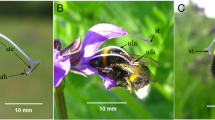Abstract
The production of unisexual flowers may favor an adjustment of floral traits to gender at plant level. In this research, the secondary sexual dimorphic traits in a native population of monoecious Jatropha curcas in Mexico were studied. Specifically, the extent and direction of the bias in sexual dimorphism of flower number and size, as well as nectar production were studied (15–20 plants). In the native population of the species, the male: female flower ratio was 7:1, whereas operational sex ratio was 2:1. Female flowers had longer and wider corollas than male flowers. Nectar-rewarding male flowers and non-rewarding female ones were observed. The extent and direction of the bias in sexual dimorphism of flower number and size, as well as nectar production were consistent with predictions based on dioecious and monoecious species in tropical region. This study highlights the important influence that population-level variation can have on variants of sexual dimorphic traits and its potential adaptive significance when viewed in the light of monoecious breeding system.


Similar content being viewed by others
References
Adriano-Anaya ML, Pérez-Castillo E, Salvador-Figueroa M, Ruiz-González S, Vásquez-Ovando A, Grajales-Conesa J, Ovando-Medina I (2016) Sex expression and floral diversity in Jatropha curcas: a population study in its center of origin. PeerJ 4:1–18
Ahoton LE, Quenum F (2012) Floral Biology and Hybridization Potential of Nine Accessions of Physic Nut (Jatropha curcas L.) Originating from Three Continents. Tropicultura 30:193–198
Barrett SCH, Yakimowski SB, Field DL, Pickup M (2010) Ecological genetics of sex ratios in plant populations. Phil Trans R Soc B 365:2549–2557
Barrett SCH, Hough J (2013) Sexual dimorphism in flowering plants. J Exp Biol 64:67–82
Bawa KS, Webb CJ, Tuttle AF (1982) The adaptive significance of monoecism in Cnidoscolus urens (L.). Arthur (Euphorbiaceae). Bot J Linn Soc 85:213–223
Bhattacharya A, Datta K, Datta SK (2005) Floral Biology, Floral Resource Constraints and Pollination Limitation in Jatropha curcas L. Pak J Biol Sci 8:456–460
Brasileiro BG, Dos Santos Dias DCF, Bhering MC, dos Santos Dias LA (2012) Floral biology and characterization of seed germination in physic nut (Jatropha curcas L.). Rev Bras Sementes 34:556–562
Chang-wei L, Kun L, You C, Yong-yu S (2007) Floral display and breeding system of Jatropha curcas L. For Stud China 9:114–119
Concepts Abacous (1989) Abacous Concepts. SuperAnova Reference, Abacous Concepts, Berkeley, California, USA
Concepts Abacous (1996) Abacous Concepts. StatView Reference, Abacous Concepts, Berkeley, California, USA
Dasumiati Miftahudin, Triadiati T, Hartana A (2017) Sex types in flowering of Jatrophas curcas. Biodiversitas 18:442–446
Delph LF, Galloway LF, Stanton ML (1996) Sexual dimorphism in flower size. Amer Nat 148:299–320
Dorken ME, Barrett SCH (1988) Life-history differentiation and the maintenance of monoecy and dioecy in Sagittaria latifolia (Alismataceae). Evolution 57:1973–1988
Emler ST, Oring LW (1977) Ecology, sexual selection, and the evolution of mating systems. Science 197:215–223
Fresnedo-Ramírez J (2013) The floral biology of Jatropha curcas L.- A review. Tropical Plant Biol 6:1–16
Grajales-Conesa J, Aceves-Chong L, Rincón-Rabanales M, Cruz-López L (2016) Jatropha curcas flowers from southern Mexico: chemical profile and morphometrics. Rev Mex Bio 87:1–7
Harder LD, Barrett SCH (1996) Pollen dispersal and mating patterns in animal-pollinated plants. In: Lloyd DG and SCH Barrett (eds). Floral biology. Studies of floral evolution in animal-pollinated plamts. New York, Chapman and Hall, pp. 140-190
Hernández-Ramírez AM, García-Méndez S (2015) Diversidad, estructura y regeneración de la selva tropical estacionalmente seca de la Península de Yucatán, México. Rev Biol Trop 63:603–616
Hui W, Yang Y, Wu G, Peng C, Chen X, Zayed MZ (2017) Transcriptome profile analysis reveals the regulation mechanism of floral sex differentiation in Jatropha curcas L. Sci Rep 7:1–13
Juhász AP, Pimenta S, Soares BO, Morais DDLB, Rabello HDO (2009) Floral biology and artificial pollination in physic nut in the north of Minas Gerais state, Brazil. Pesq agropec bras Brasília 44:1073–1077
Kaur K, Dhillon GPS, Gill RIS (2011) Floral Biology and breeding system of Jatropha curcas in North-western India. J Trop For Sci 23:4–9
Luo CW, Huang ZY, Chen XM, Li K, Chen Y, Sun YY (2011) Contribution of diurnal and nocturnal insect to the pollination of Jatropha curcas (Euphorbiaceae) in Southwestern China. J Econ Entomol 104:149–154
Makkar HPS, Aderibigbe AO, Becker K (1998a) Comparative evaluation of non-toxic and toxic varieties of Jatropha curcas for chemical composition, digestibility, protein degradability and toxic factors. Food Chem 62:207–215
Makkar HPS, Becker K, Schmook B (1998b) Edible provenances of Jatropha curcas from Quintana Roo state of Mexico and effect of roasting on antinutrient and toxic factors in seeds. Plant Foods Hum Nutr 52:31–36
Negussie A, Achten WMJ, Verboven HAF, Hermy M, Muys B (2013) Floral display and effects of natural and artificial pollination on fruiting and seed yield of the tropical biofuel crop Jatropha curcas L. GCB Bioenergy. https://doi.org/10.1111/gcbb.12072
Nietsche S, Vendrame WA, Crane JH, Pereira MCT (2013) Assessment of reproductive characteristics of Jatropha curcas L. in south Florida. GCB Bioenergy https://doi.org/10.1111/gcbb.12051
Pranesh KJ, Rao MRG, Sowmya HC, Gowda B, Savithramma DL, Naveen NL (2010) Studies on floral display and mode of reproduction in jatropha (Jatropha curcas L.). Electr J Plant Breeding 1:832–838
Raju SAJ, Ezradanam V (2002) Pollination ecology and fruiting behaviour in a monoecious species, Jatropha curcas L. (Euphorbiaceae). Curr Sci 83:1395–1398
Renner SS, Feil JP (1993) Pollinators of Tropical dioecious Angiosperms. Am J Bot 80:1100–1107
Rianti P, Suryobroto B, Atmowidi T (2010) Diversity and effectiveness of insect pollinators of Jatropha curcas L. (Euphorbiaceae). HAYATI J Biosci 17:38–42
Romero MJ, Quezada-Euán JJG (2013) Pollinators in biofuel agricultural systems: the diversity and performance of bees (Hymenoptera: Apidae) on Jatropha curcas in Mexico. Apidologie 44:419–429
Wu J, Liu Y, Tang L, Zhang F, Chen F (2011) A study on structural features in early flower development of Jatropha curcas L. and the classification of its inflorescences. Afr J Agric Res 6:275–284
Xu G, Huang J, Yang Y, Yao Y (2016) Transcriptome analysis of flower sex differentiation in Jatropha curcas L. using RNA sequencing. PLoS ONE 11:1–21
Zar JH (1999) Biostatistical Analysis (Fourth Edition), Prentice Hall
Acknowledgements
I thank Canto family for granting permission to carry out the fieldwork in their farm. I am also grateful to Paul M. Ramsay, and two anonymous reviewers for greatly improving an earlier version of this manuscript.
Author information
Authors and Affiliations
Corresponding author
Additional information
Communicated by Paul M. Ramsay.
Publisher's Note
Springer Nature remains neutral with regard to jurisdictional claims in published maps and institutional affiliations.
Rights and permissions
About this article
Cite this article
Hernández-Ramírez, A.M. New insights into secondary sexual dimorphic traits in monoecious Jatropha curcas L. (Euphorbiaceae) in Quintana Roo, Mexico. Plant Ecol 220, 433–440 (2019). https://doi.org/10.1007/s11258-019-00925-0
Received:
Accepted:
Published:
Issue Date:
DOI: https://doi.org/10.1007/s11258-019-00925-0




